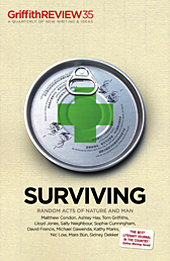Featured in

- Published 20120306
- ISBN: 9781921922008
- Extent: 264 pp
- Paperback (234 x 153mm), eBook

Already a subscriber? Sign in here
If you are an educator or student wishing to access content for study purposes please contact us at griffithreview@griffith.edu.au
Share article
More from author

Green and pleasant memories
Reportage‘CAN WE MEET later?’ reads the text message. ‘I’ve got to support someone in court.’ I had arrived at the shopping centre in the...
More from this edition

Life and death on the high seas
ReportageON A SULTRY mid-December day an Indonesian fishing boat manned only by its skipper chugged out of the port of Muara Angke, in north...

Interview with
Michael Gawenda
InterviewYou begin your piece with your personal experience of writing two stories that may have compromised their subjects. Did you feel you needed to...

The path to resilience
EssayGREENSBURG, KANSAS, IN America's agricultural heartland, is by no means a greenie enclave. It's tornado country. On 4 May 2007 an EF5 rated tornado...